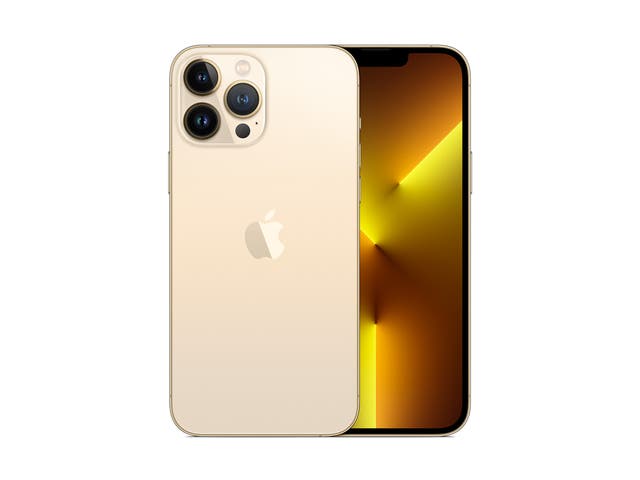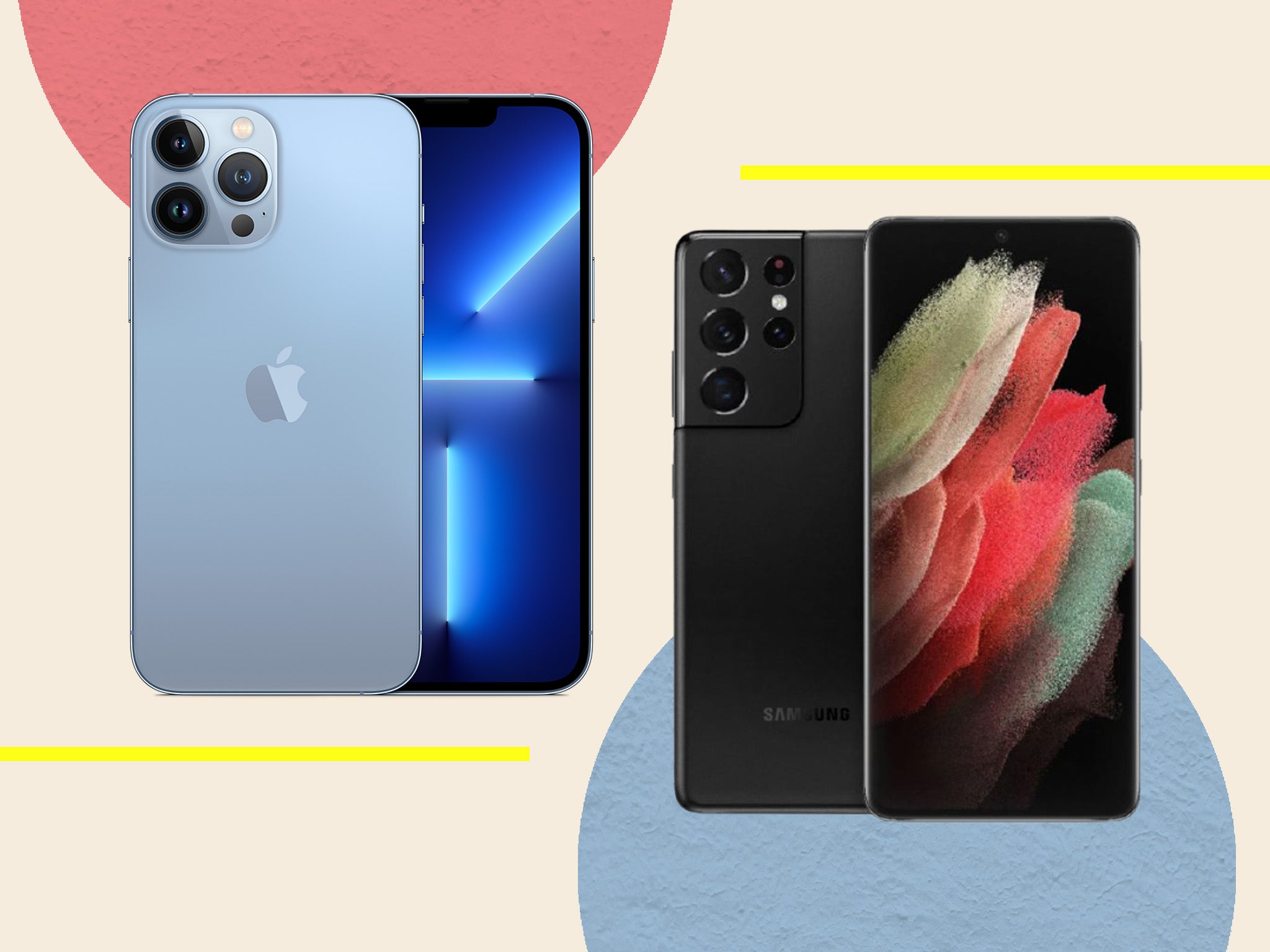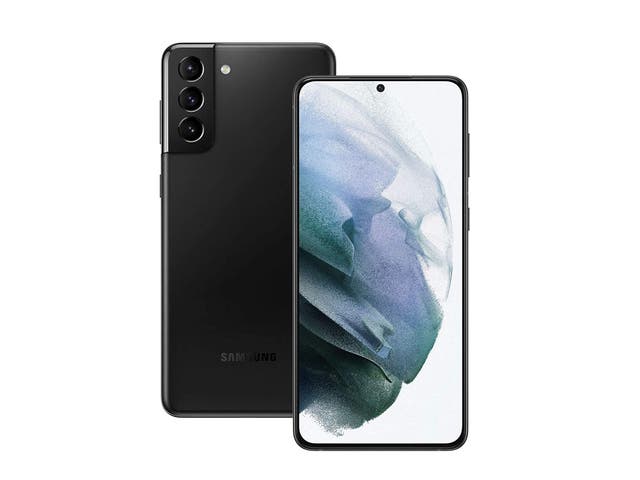
The Independent's journalism is supported by our readers. When you purchase through links on our site, we may earn commission. Why trust us?
iPhone 13 pro max vs Samsung Galaxy S21 plus: Which supersized smartphone comes out on top?
Once again, it’s a battle between the two tech titans

You have to hand it to Apple and Samsung, the top of the smartphone game is a saturated marketplace, yet both brands continue to deliver consistently popular models.
Be it brand loyalty, software habituation (we’re mainly looking at Apple there) or leaps in technology, the two phone giants sit comfortably among the biggest smartphone producers.
One surprising trend that both have tapped into is the move back towards big screens. No longer is it better to have a smartphone that fits neatly into your pocket: as the power of our handsets grows, so too does the need for a bigger screen.
There’s no chance of revisiting the era of big blocky beasts that barely deserved the “mobile” label, though – these phones are bigger, but no less beautiful.
But do we really need phones to keep growing? When does a smartphone become a tablet, and do the iPhone 13 pro max and Samsung Galaxy S21+ risk veering into that category? Basically: does size matter?
Read more:
How we tested
We got our hands on the iPhone 13 pro max and Samsung Galaxy S21+ and put them through their paces to see which supersized smartphone came out on top. We started with the look and feel of each phone: does it exude a premium feel? Have the designers found the right balance between luxury and sturdiness, and is it comfortable to use for long periods?
We then moved on to the display and sound, focusing on both the strength of the screen but also the quality of the display beneath, noting the richness and detail of each. Our final category was power and performance, from processing speeds to battery life and camera quality. Here’s what we found.
Apple iPhone 13 pro max

Buy now £1,049, Apple.com
Rating: 10/10
- Dimensions: 160.8mm x 78.1mm x 7.65mm
- Weight: 238g
- Display: 6.7in super retina XDR display with ProMotion
- Battery: Up to 22 hours video playback
- Chipset: A15 Bionic Chip, 6-core CPU
- OS: iOS 15
- Camera: Pro 12MP camera system: telephoto (ƒ/2.8 aperture), wide (ƒ/1.5 aperture) and ultra wide (ƒ/1.8 aperture and 120° field of view); front 12MP (ƒ/2.2 aperture)
- Water resistance: IP68
Design
While both handsets have similar dimensions, there’s one that clearly takes the title of chunkiest phone: the iPhone 13 is a big boy. Despite actually taking up a similar amount of space to the Samsung S21+, the iPhone feels much sturdier. This isn’t to say that it feels like a brick in the hand – far from it. The extra presence is channelled into an industrial aesthetic, reminiscent of Bauhaus, so that it feels like a proper “machine”, as opposed to just a phone.
What isn’t Bauhaus, however, is the iPhone’s camera bump. It’s almost prohibitively bulging: no chance to type with it on the table, unless you want to try flipping your phone it were a tiddlywink.
Despite this slightly frustrating feature, the phone’s finish is particularly luxurious, with beautiful pastel colour options (including our favourite, the new “alpine green”) and sophisticated metallic sides. The back does show condensation if outside in the cold or after exercise, and the metallic sides manage to pick up every slight potential for smudging, which is a shame, but the clean, industrial aesthetic gives the iPhone 13 the air of something more than a smartphone.
Display and performance
The iPhone 13 pro max’s A15 Bionic chipset is one of the quickest we’ve had the pleasure of testing. Transitioning between apps and screen feedback is as smooth as you could hope for, thanks to the 120Hz refresh rate. Its 6.7in super retina XDR display also takes some beating, producing crystal clear graphics and text that could just as easily be seen on a top-range laptop, especially when dealing with a warmer colour palette. The iPhone’s promisingly titled ProMotion display is, in general, a major upgrade on previous iPhones, and feels like the next step in smartphone screens.
The iPhone 13’s sound quality is among the best we’ve ever heard from a phone. The power is seriously impressive – its lowest level is as clear as many phones we’ve tested in the past at their highest. It’s elements like this where you can really tell the difference between a mid-range handset and a premium offering. There’s an almost tangible superiority of sound that emanates from the iPhone 13 pro max, as if its designers sold their soul to the devil for a more direct connection to our ears.
Combining the iPhone’s display and sound, then, it’s no exaggeration to say that the iPhone 13 pro max offers as good a multimedia experience as many premium laptops. It’s seriously impressive.
Camera and battery
The iPhone’s cameras are among the best in the business, and could arguably be considered the best. The camera bump is used to good effect, with extra-large sensors making the camera setup as good as anything you can get right now. The array of features on offer is more comprehensive than anything we’ve seen, with software able to produce as close to professional stills and video as you’d think possible. The depth and detail with the iPhone is outstanding – it picks up elements of a scene that are barely noticeable with the naked eye. We’re also all in on the bokeh, which flits between subjects during video recording like a director is calling the shots.
One major sticking point, fairly or otherwise, has been Apple’s less-than-stellar reputation when it comes to battery life. Luckily, the iPhone 13 improves things somewhat. Apple doesn’t release details of its batteries, but the one inside this iPhone should last you most of the day without the dreaded 1 per cent experience.
Samsung Galaxy S21+ 5G

Buy now £949, Samsung.com
Rating: 9.5/10
- Dimensions: 161.5mm x 75.6mm x 7.8mm
- Weight: 200g
- Display: 6.7in flat FHD+ dynamic AMOLED 2X
- Battery: 4,800mAh
- Chipset: Exynos 2100 5nm
- OS: Android 11
- Camera: Rear 12MP ultra wide (ƒ/2.2 aperture), 12MP wide angle (ƒ/1.8 aperture) 64MP telephoto (ƒ/2.0 aperture); front 10MP (ƒ/2.2 aperture)
- Water resistance: IP68
Design
The Samsung S21+ is a slender, unassuming phone that takes classic design elements and smooths them out into a sophisticated silhouette and structure. The matte black finish to the back is a lovely premium addition, elevating what is, in general, a pretty standard design to a more upmarket audience. The finish also somehow manages to avoid any major smudging, something of which black phones can sometimes fall majorly foul.
The Samsung manages to offer a sturdy handset with all the looks of a much more fragile example – its slim profile hide a strong frame, with no bend during stress testing. Overall, this is a premium phone that would suit any walk of life. Its IP68 rating also means there are minimal worries when using it out and about or when doom scrolling while in the bath (don’t worry, we do it too).
Display and performance
Samsung’s in-house Exynos 2100 chipset delivers a crisp, rapid experience rarely seen anywhere, let alone in the saturated Android market. Juggling multiple apps and media is a doddle, as is playing your favourite mobile games, and the overall user experience is clean, snappy and hassle-free.
The Samsung’s display, while regrettably only offering Full HD+ instead of the QHD+ seen in other models, still performs brilliantly, especially with cooler colour palettes, and this shift down enables a longer battery life and less of an impact on your wallet. The AMOLED screen and dynamic refresh rate of up to 120Hz combine well when optimising the user experience by sensing what you’re doing, and changing accordingly, pumping up the refresh rate for more demanding situations (a particularly intense game of Candy Crush) while settling during some more downtime (like reading the internet) in order to save battery.
There’s also impressive audio clarity, and a range of frequencies is dealt with without fuss. The sound is generally very nimble, and much better than handsets both in the middle of the market and many rivals. There’s a distinct lack of tinniness that you almost expect from your smartphone when compared to larger devices: the audio sophistication means there’s no risk of feeling short changed.
Camera and battery
The Samsung’s cameras are classic Samsung. The S21’s setup is pretty similar to previous iterations – main and ultra-wide cameras at 12MP and a 64MP zoom lens – and continues to be among the very best on the market, producing refreshingly bright shots with plenty of detail. The selfie camera does enough to be recommended without blowing minds, and video capability is high, meaning on-the-go conference calls or your next great home movie are both realistic goals.
Battery is where Samsung usually comes into its own, and the S21+ is no exception. The 4,800 mAh battery reigns supreme over most other high-end phones, including the iPhone, comfortably lasting a full day with heavy usage. No need to worry about taking a portable charger on the commute.
The verdict: iPhone 13 pro max vs Samsung Galaxy S21+ 5G
Apple is sometimes accused of an element of repackaging when it comes to new iPhones. The 13 pro max, however, feels like a tangible leap from the previous generation, one that’s a no-brainer for Apple users who are on the lookout for their next mobile. From the A15 Bionic chipset to the ProMotion display and phenomenal camera setup, you’d be hard-pressed to find a better phone anywhere.
The Samsung Galaxy S21+ 5G is everything you want from an Android phone. User experience is snappy and hassle-free, and the screen quality in some instances outboxes its rival, especially with the impressive dynamic refresh rate. It enjoys a clean and sturdy design, great camera setup and beefy battery that all give its software a strong base on which to work its magic. For loyal Android users, the S21+ is suitable reward.
Both the iPhone 13 pro max and Samsung Galaxy S21+ 5G are definitively at the top end of the smartphone market. The premium nature of each was evident throughout testing, from screen and sound quality, to processing speed and design. Both phones feel like different beasts to most of the market, and would be worthy handsets for dedicated fans of iOS and Android respectively. However, in terms of pure ability and experience, the iPhone edges the debate. It simply feels like another level of smartphone.
Voucher codes
For the latest mobile phone discounts and other tech offers, try the links below:
Find the best iphone mobile deals at Independent compare
Looking to compare even more handsets? Check out our review of the best smartphones available now from Google, Huawei and more
